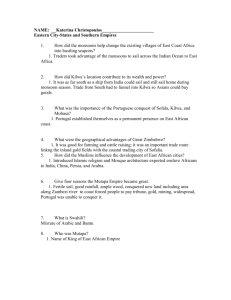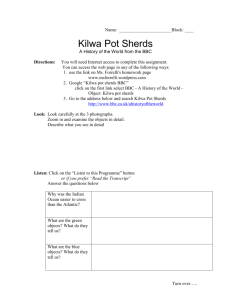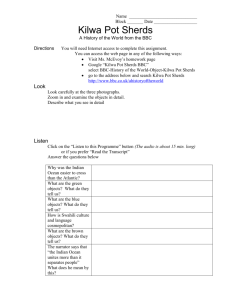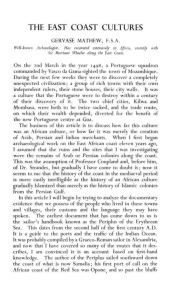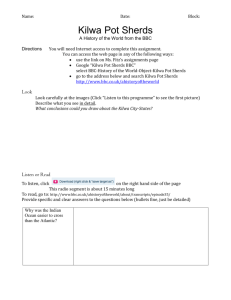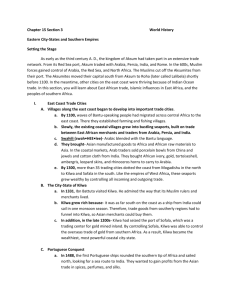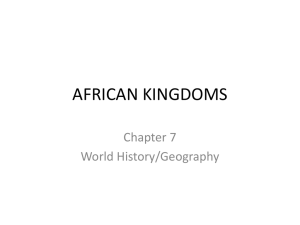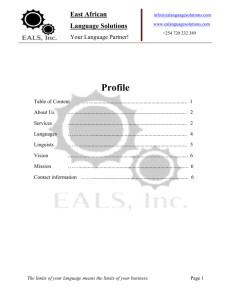The wealth of Africa The Swahili Coast
advertisement
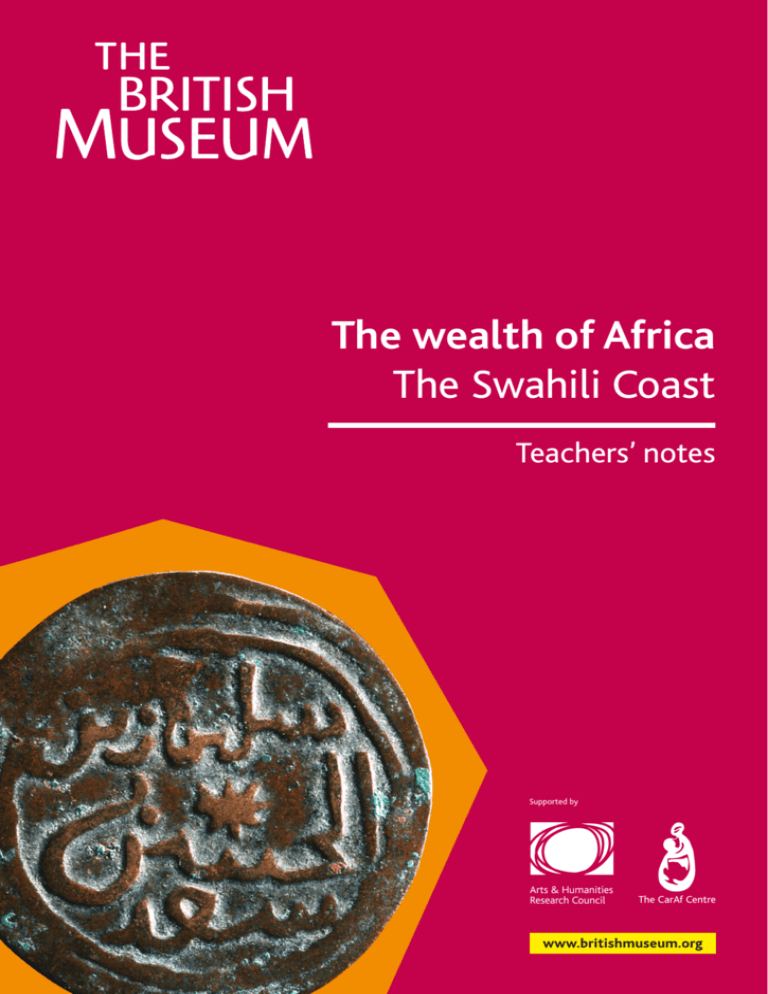
The wealth of Africa The Swahili Coast Teachers’ notes Supported by The CarAf Centre www.britishmuseum.org The wealth of Africa The Swahili Coast THE WEALTH OF AFRICA: USING THESE RESOURCES This educational resource consists of 16 sets of resources on African civilisations, countries and themes. Each set of resources includes: Each set of resources includes: • Teachers’ notes • Students’ worksheets • A Presentation Download the resources free at www.britishmuseum.org/schools Teachers’ notes These are intended to provide background material for teachers, but can also be referred to by students who want more contextual information. Students’ worksheets These are stand-alone worksheets which can be downloaded as classroom resources or viewed on the interactive whiteboard. They are self-contained, with tasks and questions and a limited number of sources in which the language has been slightly amended to make them more accessible to the likely reading ages of the students. They are also designed to be used independently of the teacher, e.g. for homework. If teachers do not wish to spend more than one or two lessons on the Swahili Coast, then the sheets will prove ideal for small project work, with groups of students taking one sheet, finding interesting and relevant information, and reporting back to the rest of the class. A specimen lesson plan along these lines is given below. Presentation This provides a simpler and more visual introduction to the civilisation. It contains some of the images and sources found in the other sections, and can be shown on the whiteboard or used at home to give an overview of the main topics covered. Your feedback Please help the British Museum improve its educational resources for schools and teachers by giving your feedback. The first 250 teachers or tutors to complete the online survey before 12.00 on 1 September 2011 will receive a printed set of illustrations of African civilisations by artist Tayo Fatunla. Visit www.surveymonkey.com/s/wealthofafrica to complete the survey and for terms and conditions. Front cover image: Coin with rhyming inscription from Kilwa, British Museum 1 The wealth of Africa The Swahili Coast LESSON SCHEME: KILWA IN AN HOUR Aim To decide how advanced Kilwa was. Starter: Impressions of Kilwa and the Swahili Coast Scroll quickly through images in the presentation, and get feedback from students on their first impressions, especially on how advanced they consider the civilisation to have been. (10 minutes) Research Divide the class into groups with one group per resource sheet. Each group has to look at the question at the top of the sheet, and decide on the answer by studying the sources. The group should note 5–10 relevant facts that it can feed back to the rest of the class as evidence of its answer. (20 minutes) Feedback Each group feeds back its findings, opinion and evidence to the rest of the class, who could take notes. (15 minutes) Discussion Students could debate the question of how well organised, prosperous and powerful Kilwa was. (15 minutes) Homework e.g. A merchant from Kilwa defends his city – pick and explain five details that show how advanced Kilwa was at this time, or look at the presentation if not already done in class, or do further research into one of the topics to find more information. 2 The wealth of Africa The Swahili Coast THE SWAHILI COAST c. AD 900–1500: TEACHERS’ NOTES Introduction The east coast of Africa, comprising the coastal areas of modern nations of Somalia, Kenya, Tanzania and Mozambique, has developed an identity very different from that of other African regions. This is partly due to the assimilation of Islamic and Persian culture through traders, which has given it a unique mixture of African and Middle Eastern influences, as well as strong links with India. This was increased by the arrival and acceptance of Islam as a religion and a way of life. Furthermore, since these early times, the people of the coast have looked outwards, to the ocean, giving them a cosmopolitan attitude which has been enhanced by their skill as traders. Although linked by this common heritage and tradition, the communities of the Swahili Coast did not comprise a single political unit, but instead a collection of independent city-states that rivalled each other for influence and control over the sources of trade. Why study the Swahili Coast? This area is significant not just because it covers an extensive strip of the continent’s coastline, but because it represents an important aspect of Africa’s relationship with the world, and links between Africa and Asia present a contrast to other sections of this resource, which focus on links between Africa and Europe. For students of History following the English National Curriculum, the Swahili Coast is an interesting example of a thriving African civilisation, with sophisticated commercial systems, and forming part of the international economy, long before the Europeans arrived. There are clear links with the resources of Great Zimbabwe, since it was gold from this source finding its way to the port of Sofala which accounted for much of the wealth of the region. In terms of the wealth of Africa, the Swahili Coast is connected with trade, and with the exploitation of gold resources from the interior. In this way, the Swahili Coast played an important role in making Africa a part of the international economy. Geography The Swahili Coast, as the title suggests, was the coastal belt running a thousand miles from Mogadishu in the north to Sofala (near modern Beira, Mozambique) in the south, and also including the islands in between. Towns surrounding the natural harbours along this coast grew into small city-states, principally Kilwa, Malindi, Mogadishu, Mombasa, Pate, Sofala and Zanzibar. Kilwa, in the south of modern-day Tanzania, one of the principal states and the main focus of this section, was built on a pair of islands in a sheltered bay in an excellent defensive position. 3 The wealth of Africa The Swahili Coast History The founding myth of Kilwa describes settlers and traders from Arabia and the Persian Gulf arriving, and setting up trading cities on the island. Another story describes a Persian ruler from Shiraz fleeing his own city, and being granted the island by the African ruler, perhaps in exchange for a payment in cloth. However, evidence suggests that there were African settlements there before this and oral accounts describe people moving to Kilwa from the mainland according to the season, for agricultural purposes. Archaeological evidence supports this, showing that there are African origins for many of the settlements on the coast that have been excavated. It seems as though the claim to origins in Arabia or Persia was part of the claims to legitimacy of the Swahili rulers, and that the civilisation, although strongly influenced by merchants and traders travelling down from the Gulf area, was an African one. The dating of the Sultans of Kilwa, and the major events in its history, is difficult, and there are disagreements between scholars about the chronology. In around AD 956, Sultan Ali became the first ruler of independent Kilwa, and set about expanding its influence. He may have annexed the nearby island of Mafia at this time. Soon after this, the rulers of Kilwa started to mint distinctive coins, with rhyming inscriptions naming the rulers. These provide an important source of evidence for the names of the Sultans of Kilwa, and for the trade on the East African coast. Early in the 14th century, Sultan al-Hasan ibn Sulaiman rebuilt the Great Mosque, making it the largest mosque in sub-Saharan Africa up until the 16th century, and he was also responsible for the flamboyant Palace of Husuni Kubwa with its hundred rooms. From 1370, Kilwa seems to have suffered a temporary decline. It is thought that the nearby Swahili state of Pate may have joined with Egypt to seize Malindi and later usurp Kilwa’s control of the gold trade through Sofala. The Black Death may also have played a part with the lowering of the international price of gold. In the 15th century, however, there was a revival in Kilwa under Sultan Muhammed ibn Sulaiman ‘The Just’ (r. 1412–1421). By this time power had shifted to the office of Amir (commander in chief), which became a hereditary position, and which exerted an influence over the sultans to the extent of choosing and deposing them, as well as doing most of the ruling. During this period, the whole of the Swahili Coast enjoyed a revival of fortunes due to a combination of factors. The overland route to the east had been cut by the Mongols, leaving the sea route via the east African coast as the alternative. Several large trading fleets were sent by the Chinese to Africa, and an insatiable demand for eastern spices, particularly in Europe, helped put the city-states of the Swahili Coast, which acted as middle-men, back in the centre of international trade. Unfortunately, it also attracted the attention of the Portuguese who sacked Kilwa in 1505 and put a temporary end to the power of the coastal states. 4 The wealth of Africa The Swahili Coast Trade The wealth of Kilwa depended on trade in timber, ivory and other goods from the interior of Africa which were then exchanged with merchandise from Arabia and India and East Asia. Perhaps the most important commodity was gold, which was mined in the area of the African city of Great Zimbabwe and taken to the port of Sofala, from where it was shipped up the coast via Kilwa. There was also an overland route from Kilwa to Lake Nyasa and the Zambezi but this was always secondary to the sea route. The sultans of Kilwa seem to have gained direct control of Sofala around 1180. Other goods from the African interior included copper, iron, coconuts, ivory and rhinoceros horn. In exchange, porcelain from China, and jewellery, glass, and cloth from India flowed through Kilwa and into the continent. Those who wished to trade could either do so directly at Sofala, or through the sultan at Kilwa. Either way, traders were charged both import and export duties, of which were said to be high, though not enough to act as a deterrent. The wealth brought in by the gold trade meant that Kilwa minted its own coins and the wealth of Kilwa was legendary. It was mentioned by Milton in Paradise Lost where it is called ‘Quiloa’ after the Portuguese name for the city. In the early 15th century, the Chinese started equipping a series of huge fleets to develop the routes to India and beyond. Zheng He’s sixth expedition (1421–1424) reached the coast of east Africa, and established diplomatic relations between the Ming dynasty and Mogadishu, Malindi, Mombasa, Zanzibar, Dar es Salaam and Kilwa. In 1415, a giraffe was taken from Malindi to Beijing as a diplomatic gift for the Chinese emperor, where it caused great excitement. Some Chinese porcelain has been found in Kilwa, and Chinese coins have been found on the East African coast, indicating that there was trade between the two. One natural benefit for the Swahili Coast was the behaviour of the monsoon winds, which blow regularly from India to Africa from October to April, and in the other direction from June to September. These winds were so strong that they affected the currents too and made sailing easy, encouraging trade around the Indian Ocean. Kilwa Life on Kilwa was very pleasant at its peak – from the 1100s until the 1500s. At the time the Portuguese arrived, its population was somewhere between 5,000 and 10,000. The Sultan lived in a 100-room palace, the Husuni Kubwa, a short distance from the town, was which apparently built between 1315 and 1330 for the Sultan Al-Hasan ibn Sulaiman at the height of Kilwa’s prosperity. It seems to have been a mixture of private palace and trading centre, since much of the complex is made up of a trading courtyard and storerooms. It also had a bathing pool and luxurious royal apartments, especially designed to catch the cool sea breezes. It may have been in use for only a short time, perhaps only the lifespan of this one sultan. The wealthiest lived in multi-level coral rag stone houses. There were lush gardens with fountains and exotic animals imported from the mainland roaming free. The less affluent lived in traditional huts. They attended to Kilwa’s cotton crop which, either in its raw state or made into cloth, was used to barter for goods and services. Most of the residents wore tattoos or some form of scarification on their faces, indicating that not all of the local traditions had been displaced by Islam. 5 The wealth of Africa The Swahili Coast Malindi Malindi was another trading city of the Swahili Coast which lay to the north of Kilwa in what is now Kenya. The population in the 14th century was around 6,000. Malindi stretched for about 600 metres along the seafront and up to 250 metres inland, with walls surrounding the town. The rulers and wealth merchants lived inside the walls in stone houses, while poorer people mainly lived outside in mud-and-wattle huts with palm thatch roofs. In common with Kilwa, the stone houses were rectangular and multi-storied, made out of coral stone blocks with flat roofs and mangrove rafters used to support the ceiling. The rooms were designed around a central courtyard. Around Malindi were large plantations with fruits (lemons, oranges), coconut palm trees, vegetables (millet, rice, sugar cane), and cattle. Slaves and ivory were exported. Sources Despite Swahili society of the time being literate, it is hard to find much about daily life during the period of Kilwa’s greatness. The Kilwa Chronicle, describes the actions of its kings, and the information provided by Ibn Battuta on his solitary visit is sparse. Portuguese travellers and conquerors offer a little more, but not enough for a full understanding. Archaeological evidence is probably the most illuminating, and the work of Neville Chittick at Kilwa, who uncovered the great palace at Husuni Kubwa, reveals valuable information. More recent excavations are providing more details about daily life, and about other coastal settlements. Such research seems to be growing in pace bringing hope of greater understanding of the society and cultures of the age. 6 The wealth of Africa The Swahili Coast REFERENCES Barbosa, D, 1921, ‘The East Coast of Africa’, The Book of Duarte Barbosa: An Account of the Countries Bordering the Indian Ocean, 2 vols. (Hakluyt Society) BBC World Service, no date, ‘The Swahili’, online at http://www.bbc.co.uk/worldservice/africa/features/storyofafrica/index_section5.shtml , accessed 21 May 2010 Davidson, B, 1968, East and Central Africa to the late nineteenth century (Longman) Elkiss, T, 1973, ‘Kilwa Kisiwani: The Rise of an East African City-State’, African Studies Review Vol. 16, No. 1, 119–130 Freeman-Grenville, G, 1962, The East African Coast: select documents from the first to the earlier nineteenth century (Clarendon Press) Gadzekpo, S, 1999, History of African Civilisations (Royal Crown Press) Garlake, P, 1966, The early Islamic architecture of the East African Coast (British Institute in Eastern Africa) Hamdun, S & King, N, 1998, Ibn Battuta in Black Africa (Markus Wiener) Moon, K, 2005, Kilwa Kisiwani: ancient port city of the East African coast (Tanzania Ministry of Natural Resources and Tourism) Posnansky, M, 1978, ‘Review: Kilwa: An Islamic Trading City on the East African Coast’, The International Journal of African Historical Studies Vol. 11, No. 3, 496–502 7 Your feedback Please help the British Museum improve its educational resources for schools and teachers by giving your feedback. The first 250 teachers or tutors to complete the online survey before 12.00 on 1 September 2011 will receive a printed set of illustrations of African civilisations by artist Tayo Fatunla. Visit www.surveymonkey.com/s/wealthofafrica to complete the survey and for terms and conditions. Find out more The British Museum’s collection spans over two million years of human history and culture, all under one roof and includes world-famous objects such as the Rosetta Stone, the Parthenon sculptures, and Egyptian mummies. The Museum’s collection of over 200,000 African objects includes material from ancient to contemporary cultures. Highlights on display throughout the Museum include a magnificent brass head of a Yoruba ruler from Ife in Nigeria, vibrant textiles from across the continent, and the Throne of Weapons – a sculpture made out of guns. For students Students can experience and engage with the collection in many ways, from taking part in activity sessions at the Museum to using free online resources or playing interactive games in the classroom and at home. For teachers Search the Museum’s collection online at www.britishmuseum.org for information about objects, including pictures to download or print. Schools and teachers enewsletter Sign up to the schools and teachers enewsletter to receive regular updates on free special exhibitions previews, teacher events and new free resources at www.britishmuseum.org/schools Ancient Civilizations websites These award-winning British Museum websites have been specially designed for students in Years 5 and 6. Each site is supported by information and guidance for teachers. www.ancientcivilizations.co.uk The CarAf Centre These resources have been produced by the British Museum in collaboration with The CarAf Centre, a community educational support centre and registered charity based in the London Borough of Camden. For more information, visit www.thecarafcentre.org.uk Great Russell Street, London WC1B 3DG Holborn, Russell Square, Tottenham Court Road Telephone +44 (0)20 7323 8000 information@britishmuseum.org www.britishmuseum.org © The Trustees of the British Museum 08/2010
